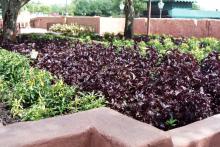Information Possibly Outdated
The information presented on this page was originally released on April 15, 2004. It may not be outdated, but please search our site for more current information. If you plan to quote or reference this information in a publication, please check with the Extension specialist or author before proceeding.
Awards selection committee chooses Purple Ruffles basil
By Norman Winter
MSU Horticulturist
Central Mississippi Research & Extension Center
You may have thought you heard it all when the Mississippi Plant Selections Committee chose the Mini Charm tomato as the first vegetable to win the award. Now the committee has chosen Purple Ruffles basil as the first herb to win the Mississippi Medallion Award.
Purple Ruffles basil is as pretty as a coleus in the flowerbed, and it also makes a delicious addition to many culinary dishes. Whether you pronouce it "bay-zil" or "baa-zil," we can agree on one thing: freshly torn Purple Ruffles basil mixed with juicy tomatoes, olive oil and garlic is a true feast when spooned over hot pasta.
Besides having extraordinary taste, Purple Ruffles basil is incredibly easy to grow. Not only does it add grace to the herb garden or tomato planting, but the numerous shapes and sizes make excellent additions to the perennial garden, shrub border or container garden. It actually partners well with two of this year's Mississippi Medallion award winners -- the Mini Charm tomato and the Port Gibson Pink verbena.
Purple Ruffles basil can be tucked into unused garden corners, displayed among vegetables, edged along a flower garden or grown in mixed containers where its handsome foliage contrasts with bouquets of colorful flowers.
Purple Ruffles basil asks for nothing more in the garden than full sun and well-drained soil. Prepare the soil by spreading 3 to 4 inches of organic matter and 1 pound per 100 square feet of a slow release, 5-10-5 fertilizer, and till to a depth of 8 to 10 inches.
Set transplants 18 to 24 inches apart. They will grow to around 2 feet tall and wide. Water and apply a layer of mulch. Purple Ruffles basil thrives in our warm summer weather and excels in fall plantings as well.
Keep the Purple Ruffles watered and harvested and flower buds pinched for a long crop. Harvest just as the flower buds are forming for the most concentrated oils, flavor and fragrance. Apply a light application of the above fertilizer every four to six weeks, or after harvest.
Cut or pinch Purple Ruffles just above a leaf or pair of leaves, removing no more than one-fourth of the plant. This leaves enough foliage to keep the plant healthy and looking good in the landscape.
Simple air-drying produces tasty Purple Ruffles basil for use all winter. Rinse the leaves in cool water and gently shake off extra moisture. When thoroughly dry, tie a handful of stems firmly into a bundle. Place the bundle in a paper bag, gather the top of the bag around the stems and tie again. Label, then hang the bag in a dry place where the temperature doesn't get above 80 degrees. After two to four weeks, the herbs should be dry and crumbly.
Once basil is dried, store it in an airtight container in a cool, dark cupboard. Keep the leaves whole if possible to preserve the oils; crush or grind only when using them.
Garden centers are loaded with Purple Ruffles transplants just waiting for your visit this weekend.
For a fresh homemade pesto try:
- 1/2 cup of extra virgin olive oil
- 2 cloves of garlic
- 2 cups of fresh Purple Ruffles basil leaves
- 1/2 cup of parsley
- 1/4 cup of toasted pine nuts
- 1/2 cup of Romano or Parmesan cheese
Place all ingredients in a food processor and puree. For best flavor, use immediately.



